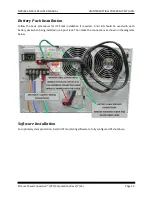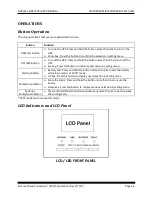
NXRi-6KL, NXRi-10KL USER MANUAL
UNINTERRUPTIBLE POWER SUPPLY (UPS)
Xtreme Power Conversion® (XPC) Corporation (Rev 2/7/13)
Page 34
2.
Some warning alarms cannot be muted unless the error is fixed.
Operation in Fault Mode
1.
When the Fault Mode LED is illuminated and the buzzer sounds continuously, there is a fatal
error in the UPS. Fault Codes are available via the LCD Panel. Refer to the Trouble Shooting
table for additional details.
2.
Check the loads, wiring, ventilation, utility, battery, etc when a fault occurs. Do not try to
turn the UPS on again before solving the problems. If the problems cannot be fixed, please
contact trained service personnel immediately.
3.
In case of emergency, disconnect the UPS from the utility, external battery, and output
immediately to avoid danger.
Operation of Changing Battery Numbers
1.
This operation should only be performed by trained and qualified professionals.
2.
Turn off the UPS. If the load cannot be shut down, remove the cover from the Maintenance
Bypass Switch on the rear panel of the UPS, and turn the Maintenance Bypass Switch to
“BPS” position.
3.
Switch off the input breaker and battery breaker.
4.
Remove the UPS cover. Modify the jumper on the control board to set the battery numbers.
Disconnect the battery wire for standard model and modify the battery pack carefully. After
completing the changes, replace UPS cover.
Note:
JP1 setting on the control board: Jumper placed on Pin 5 & 6 and Pin 7 & 8 for 20
pieces of batteries; Jumper placed on Pin 5 & 6 or Pin 7 & 8 for 19 pieces of batteries; keep
every Pin open for 18 pieces of batteries.
5.
Switch the input breaker “ON” and the UPS will enter Bypass Mode. If the UPS is in
Maintenance Bypass Mode, turn the Maintenance Bypass Switch to “UPS” position and then
turn on the UPS.
Parallel Operation
Parallel System Connection
1.
Make sure all of the UPSs are parallel models, and assure all are wired properly.
2.
Turn off the input and output breakers of each UPS, and turn off the battery breaker if the
UPS is a long runtime model (10KL).
















































